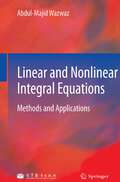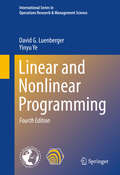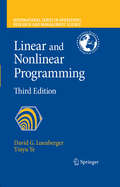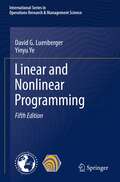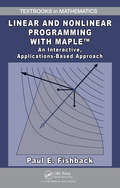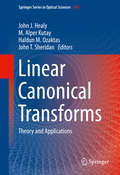- Table View
- List View
Linear and Non-linear Mechanical Behavior of Solid Materials
by Christian LexcellentThis book offers an essential introduction to the linear and non-linear behavior of solid materials, and to the concepts of deformation, displacement and stress, within the context of continuum mechanics and thermodynamics. To illustrate the fundamental principles, the book starts with an overview of solid mechanics, experimental methods, classes of material behaviors, and the thermodynamic modeling framework. It then explores linear elastic behavior, thermoelasticity, plasticity, viscoplasticity, fracture mechanics and damage behavior. The last part of the book is devoted to conventional and magnetic shape memory alloys, which may be used as actuators or sensors in adaptive structures. Given its range of coverage, the book will be especially valuable for students of engineering courses in Mechanics. Further, it includes a wealth of examples and exercises, making it accessible to the widest possible audience.
Linear and Non-Linear Video and TV Applications: Using IPv6 and IPv6 Multicast
by Daniel MinoliProvides options for implementing IPv6 and IPv6 multicast in service provider networks New technologies, viewing paradigms, and content distribution approaches are taking the TV/video services industry by storm. Linear and Nonlinear Video and TV Applications: Using IPv6 and IPv6 Multicast identifies five emerging trends in next-generation delivery of entertainment-quality video. These trends are observable and can be capitalized upon by progressive service providers, telcos, cable operators, and ISPs. This comprehensive guide explores these evolving directions in the TV/video services industry, including worldwide deployment of IPv6, IPTV services, web-produced video content, and the plethora of different screens available, from TV to iPad. It offers practical suggestions as to how these technologies can be implemented in service provider networks to support cost-effective delivery of entertainment, and how new revenue-generating services can be brought to market. Important topics include: Evolving video consumption habits and possible network implications An overview of IPv6 address capabilities, protocols, quality of service (QoS), and more Process descriptions of IP multicast and IPv6 multicast approaches and challenges A detailed overview of IPTV systems and technologies, including architectural requirements, QoE and QoS, security and content protection, networks, and more Internet-based TV technologies: streaming, content distribution networks, P2P networks, and cloud computing Non-traditional video content sources and their implications Linear and Nonlinear Video and TV Applications: Using IPv6 and IPv6 Multicast is indispensable reading for planners, CTOs, and engineers at broadcast TV operations, Cable TV operations, satellite operations, Internet and IS providers, telcos, and wireless providers.
Linear and Non-Linear Video and TV Applications: Using IPv6 and IPv6 Multicast
by Daniel MinoliProvides options for implementing IPv6 and IPv6 multicast in service provider networks New technologies, viewing paradigms, and content distribution approaches are taking the TV/video services industry by storm. Linear and Nonlinear Video and TV Applications: Using IPv6 and IPv6 Multicast identifies five emerging trends in next-generation delivery of entertainment-quality video. These trends are observable and can be capitalized upon by progressive service providers, telcos, cable operators, and ISPs. This comprehensive guide explores these evolving directions in the TV/video services industry, including worldwide deployment of IPv6, IPTV services, web-produced video content, and the plethora of different screens available, from TV to iPad. It offers practical suggestions as to how these technologies can be implemented in service provider networks to support cost-effective delivery of entertainment, and how new revenue-generating services can be brought to market. Important topics include: Evolving video consumption habits and possible network implications An overview of IPv6 address capabilities, protocols, quality of service (QoS), and more Process descriptions of IP multicast and IPv6 multicast approaches and challenges A detailed overview of IPTV systems and technologies, including architectural requirements, QoE and QoS, security and content protection, networks, and more Internet-based TV technologies: streaming, content distribution networks, P2P networks, and cloud computing Non-traditional video content sources and their implications Linear and Nonlinear Video and TV Applications: Using IPv6 and IPv6 Multicast is indispensable reading for planners, CTOs, and engineers at broadcast TV operations, Cable TV operations, satellite operations, Internet and IS providers, telcos, and wireless providers.
Linear and Nonlinear Circuits: Volume 1 (Lecture Notes in Electrical Engineering #441)
by Mauro Parodi Marco StoraceThis book provides readers with the necessary background information and advanced concepts in the field of circuits, at the crossroads between physics, mathematics and system theory. It covers various engineering subfields, such as electrical devices and circuits, and their electronic counterparts. Based on the idea that a modern university course should provide students with conceptual tools to understand the behavior of both linear and nonlinear circuits, to approach current problems posed by new, cutting-edge devices and to address future developments and challenges, the book places equal emphasis on linear and nonlinear, two‐terminal and multi‐terminal, as well as active and passive circuit components. The theory is developed systematically, starting with the simplest circuits (linear, time-invariant and resistive) and providing food for thought on nonlinear circuits, potential functions, linear algebra and geometrical interpretations of selected results. Contents are organized into a set of first‐level and a set of advanced‐level topics. The book is rich in examples and includes numerous solved problems. Further topics, such as signal processing and modeling of non-electric physical phenomena (e.g., hysteresis or biological oscillators) will be discussed in volume 2.
Linear and Nonlinear Circuits: Volume 2 (Lecture Notes in Electrical Engineering #620)
by Mauro Parodi Marco StoraceThis book provides readers with the necessary background information and advanced concepts in the field of circuits, at the crossroads between physics, mathematics and system theory. It covers various engineering subfields, such as electrical devices and circuits, and their electronic counterparts. Based on the idea that a modern university course should provide students with conceptual tools to understand the behavior of both linear and nonlinear circuits, to approach current problems posed by new, cutting-edge devices and to address future developments and challenges, the book places equal emphasis on linear and nonlinear, two‐terminal and multi‐terminal, as well as active and passive circuit components. This second volume focuses on dynamical circuits, which are characterized by time evolution and by the concept of state. The content is divided into a set of introductory and a set of advanced‐level topics, mirroring the approach used in the previously published volume. Whenever possible, circuits are compared to physical systems of different natures (e.g. mechanical or biological) that exhibit the same dynamical behavior. The book also features a wealth of examples and numerous solved problems. Further topics, such as a more general framing of linear and nonlinear components, will be discussed in volume 3.
Linear and Nonlinear Control of Small-Scale Unmanned Helicopters (Intelligent Systems, Control and Automation: Science and Engineering #45)
by Ioannis A. Raptis Kimon P. ValavanisThere has been significant interest for designing flight controllers for small-scale unmanned helicopters. Such helicopters preserve all the physical attributes of their full-scale counterparts, being at the same time more agile and dexterous. This book presents a comprehensive and well justified analysis for designing flight controllers for small-scale unmanned helicopters guarantying flight stability and tracking accuracy. The design of the flight controller is a critical and integral part for developing an autonomous helicopter platform. Helicopters are underactuated, highly nonlinear systems with significant dynamic coupling that needs to be considered and accounted for during controller design and implementation. Most reliable mathematical tools for analysis of control systems relate to modern control theory. Modern control techniques are model-based since the controller architecture depends on the dynamic representation of the system to be controlled. Therefore, the flight controller design problem is tightly connected with the helicopter modeling. This book provides a step-by-step methodology for designing, evaluating and implementing efficient flight controllers for small-scale helicopters. Design issues that are analytically covered include: • An illustrative presentation of both linear and nonlinear models of ordinary differential equations representing the helicopter dynamics. A detailed presentation of the helicopter equations of motion is given for the derivation of both model types. In addition, an insightful presentation of the main rotor's mechanism, aerodynamics and dynamics is also provided. Both model types are of low complexity, physically meaningful and capable of encapsulating the dynamic behavior of a large class of small-scale helicopters. • An illustrative and rigorous derivation of mathematical control algorithms based on both the linear and nonlinear representation of the helicopter dynamics. Flight controller designs guarantee that the tracking objectives of the helicopter's inertial position (or velocity) and heading are achieved. Each controller is carefully constructed by considering the small-scale helicopter's physical flight capabilities. Concepts of advanced stability analysis are used to improve the efficiency and reduce the complexity of the flight control system. Controller designs are derived in both continuous time and discrete time covering discretization issues, which emerge from the implementation of the control algorithm using microprocessors. • Presentation of the most powerful, practical and efficient methods for extracting the helicopter model parameters based on input/output responses, collected by the measurement instruments. This topic is of particular importance for real-life implementation of the control algorithms. This book is suitable for students and researches interested in the development and the mathematical derivation of flight controllers for small-scale helicopters. Background knowledge in modern control is required.
Linear and Nonlinear Instabilities in Mechanical Systems: Analysis, Control and Application
by Hiroshi YabunoLinear and Nonlinear Instabilities in Mechanical Systems: Analysis, Control and Application Hiroshi Yabuno, University of Tsukuba, Japan An in-depth insight into nonlinear analysis and control As mechanical systems become lighter, faster, and more flexible, various nonlinear instability phenomena can occur in practical systems. The fundamental knowledge of nonlinear analysis and control is essential to engineers for analysing and controlling nonlinear instability phenomena. The book bridges the gap between the mathematical expressions of nonlinear dynamics and the corresponding practical phenomena. Linear and Nonlinear Instabilities in Mechanical Systems: Analysis, Control and Application provides a detailed and informed insight into the fundamental methods for analysis and control for nonlinear instabilities from the practical point of view. Key features: Refers to the behaviours of practical mechanical systems as aircraft, railway vehicle, robot manipulator, micro/nano sensor Enhances the rigorous and practical understanding of mathematical methods from an engineering point of view. The theoretical results obtained by nonlinear analysis are interpreted by using accompanied videos on the real nonlinear behaviors of nonlinear mechanical systems. Linear and Nonlinear Instabilities in Mechanical Systems: Analysis, Control and Application is an essential textbook for students on engineering courses, and can also be used for self-study or reference by engineers.
Linear and Nonlinear Instabilities in Mechanical Systems: Analysis, Control and Application
by Hiroshi YabunoLinear and Nonlinear Instabilities in Mechanical Systems: Analysis, Control and Application Hiroshi Yabuno, University of Tsukuba, Japan An in-depth insight into nonlinear analysis and control As mechanical systems become lighter, faster, and more flexible, various nonlinear instability phenomena can occur in practical systems. The fundamental knowledge of nonlinear analysis and control is essential to engineers for analysing and controlling nonlinear instability phenomena. The book bridges the gap between the mathematical expressions of nonlinear dynamics and the corresponding practical phenomena. Linear and Nonlinear Instabilities in Mechanical Systems: Analysis, Control and Application provides a detailed and informed insight into the fundamental methods for analysis and control for nonlinear instabilities from the practical point of view. Key features: Refers to the behaviours of practical mechanical systems as aircraft, railway vehicle, robot manipulator, micro/nano sensor Enhances the rigorous and practical understanding of mathematical methods from an engineering point of view. The theoretical results obtained by nonlinear analysis are interpreted by using accompanied videos on the real nonlinear behaviors of nonlinear mechanical systems. Linear and Nonlinear Instabilities in Mechanical Systems: Analysis, Control and Application is an essential textbook for students on engineering courses, and can also be used for self-study or reference by engineers.
Linear and Nonlinear Integral Equations: Methods and Applications
by Abdul-Majid WazwazLinear and Nonlinear Integral Equations: Methods and Applications is a self-contained book divided into two parts. Part I offers a comprehensive and systematic treatment of linear integral equations of the first and second kinds. The text brings together newly developed methods to reinforce and complement the existing procedures for solving linear integral equations. The Volterra integral and integro-differential equations, the Fredholm integral and integro-differential equations, the Volterra-Fredholm integral equations, singular and weakly singular integral equations, and systems of these equations, are handled in this part by using many different computational schemes. Selected worked-through examples and exercises will guide readers through the text. Part II provides an extensive exposition on the nonlinear integral equations and their varied applications, presenting in an accessible manner a systematic treatment of ill-posed Fredholm problems, bifurcation points, and singular points. Selected applications are also investigated by using the powerful Padé approximants. This book is intended for scholars and researchers in the fields of physics, applied mathematics and engineering. It can also be used as a text for advanced undergraduate and graduate students in applied mathematics, science and engineering, and related fields. Dr. Abdul-Majid Wazwaz is a Professor of Mathematics at Saint Xavier University in Chicago, Illinois, USA.
Linear and Nonlinear Iterative Learning Control (Lecture Notes in Control and Information Sciences #291)
by Jian-Xin Xu Ying TanThis monograph summarizes the recent achievements made in the field of iterative learning control. The book is self-contained in theoretical analysis and can be used as a reference or textbook for a graduate level course as well as for self-study. It opens a new avenue towards a new paradigm in deterministic learning control theory accompanied by detailed examples.
Linear and Nonlinear Optical Responses of Chiral Multifold Semimetals (Springer Theses)
by Miguel Ángel Sánchez MartínezSince the initial predictions for the existence of Weyl fermions in condensed matter, many different experimental techniques have confirmed the existence of Weyl semimetals. Among these techniques, optical responses have shown a variety of effects associated with the existence of Weyl fermions. In chiral crystals, we find a new type of fermions protected by crystal symmetries — the chiral multifold fermions — that can be understood as a higher-spin generalization of Weyl fermions.This work provides a complete description of all chiral multifold fermions, studying their topological properties and the k·p models describing them. We compute the optical conductivity of all chiral multifold fermions and establish their optical selection rules. We find that the activation frequencies are different for each type of multifold fermion, thus constituting an experimental fingerprint for each type of multifold fermion.Building on the theoretical results obtained in the first part of our analysis, we study two chiral multifold semimetals: RhSi and CoSi. We analyze the experimental results with k·p and tight-binding models based on the crystal symmetries of the material. We trace back the features observed in the experimental optical conductivity to the existence of multifold fermions near the Fermi level and estimate the chemical potential and the scattering lifetime in both materials.Finally, we provide an overview of second-order optical responses and study the second-harmonic generation of RhSi. We find a sizeable second-harmonic response in the low-energy regime associated with optical transitions between topological bands. However, this regime is extremely challenging to access with the current experimental techniques.We conclude by providing an overview of the main results, highlighting potential avenues to further research on chiral multifold semimetals and the future of optical responses as experimental probes to characterize topological phases.
Linear and Nonlinear Optical Spectroscopy and Microscopy (Progress in Optical Science and Photonics #29)
by Mengtao Sun Xijiao Mu Rui LiThe nonlinear optical spectrum signal technology is a new type of optical characterization technology owing to its non-invasiveness and good biocompatibility. This book highlights a comprehensive introduction to the Stimulated Raman scattering (SRS), Anti-Stokes Raman Spectroscopy (CARS), Two-photon Excited Fluorescence (TPEF) and Second Harmonic Generation signals (SHG) technologies. The four types of nonlinear optical signals technologies, especially two-dimensional and three-dimensional imaging, have great application potential in physics, materials science, chemistry and biomedicine. The book covers principles, theoretical calculation methods, signal measurement methods and imaging specific methods. The theoretical part starts from the basics of nonlinear optics and the relationship with strong light, and gradually transitions to theoretical calculation methods for specific optical signals. it combines the classical theory and the quantum theory to help readers develop a thorough understanding of the technologies. The book is a good reference for graduate students majored in physics and chemistry and for researchers working on optics, photonics and materials science.
Linear and Nonlinear Programming (International Series in Operations Research & Management Science #228)
by David G. Luenberger Yinyu YeThis new edition covers the central concepts of practical optimization techniques, with an emphasis on methods that are both state-of-the-art and popular. One major insight is the connection between the purely analytical character of an optimization problem and the behavior of algorithms used to solve a problem. This was a major theme of the first edition of this book and the fourth edition expands and further illustrates this relationship. As in the earlier editions, the material in this fourth edition is organized into three separate parts. Part I is a self-contained introduction to linear programming. The presentation in this part is fairly conventional, covering the main elements of the underlying theory of linear programming, many of the most effective numerical algorithms, and many of its important special applications. Part II, which is independent of Part I, covers the theory of unconstrained optimization, including both derivations of the appropriate optimality conditions and an introduction to basic algorithms. This part of the book explores the general properties of algorithms and defines various notions of convergence. Part III extends the concepts developed in the second part to constrained optimization problems. Except for a few isolated sections, this part is also independent of Part I. It is possible to go directly into Parts II and III omitting Part I, and, in fact, the book has been used in this way in many universities.New to this edition is a chapter devoted to Conic Linear Programming, a powerful generalization of Linear Programming. Indeed, many conic structures are possible and useful in a variety of applications. It must be recognized, however, that conic linear programming is an advanced topic, requiring special study. Another important topic is an accelerated steepest descent method that exhibits superior convergence properties, and for this reason, has become quite popular. The proof of the convergence property for both standard and accelerated steepest descent methods are presented in Chapter 8. As in previous editions, end-of-chapter exercises appear for all chapters.From the reviews of the Third Edition:“… this very well-written book is a classic textbook in Optimization. It should be present in the bookcase of each student, researcher, and specialist from the host of disciplines from which practical optimization applications are drawn.” (Jean-Jacques Strodiot, Zentralblatt MATH, Vol. 1207, 2011)
Linear and Nonlinear Programming (International Series in Operations Research & Management Science #116)
by David G. Luenberger Yinyu YeThis third edition of the classic textbook in Optimization has been fully revised and updated. It comprehensively covers modern theoretical insights in this crucial computing area, and will be required reading for analysts and operations researchers in a variety of fields. The book connects the purely analytical character of an optimization problem, and the behavior of algorithms used to solve it. Now, the third edition has been completely updated with recent Optimization Methods. The book also has a new co-author, Yinyu Ye of California’s Stanford University, who has written lots of extra material including some on Interior Point Methods.
Linear and Nonlinear Programming (International Series in Operations Research & Management Science #228)
by David G. Luenberger Yinyu YeThe 5th edition of this classic textbook covers the central concepts of practical optimization techniques, with an emphasis on methods that are both state-of-the-art and popular. One major insight is the connection between the purely analytical character of an optimization problem and the behavior of algorithms used to solve that problem. End-of-chapter exercises are provided for all chapters. The material is organized into three separate parts. Part I offers a self-contained introduction to linear programming. The presentation in this part is fairly conventional, covering the main elements of the underlying theory of linear programming, many of the most effective numerical algorithms, and many of its important special applications. Part II, which is independent of Part I, covers the theory of unconstrained optimization, including both derivations of the appropriate optimality conditions and an introduction to basic algorithms. This part of the book explores the general properties of algorithms and defines various notions of convergence. In turn, Part III extends the concepts developed in the second part to constrained optimization problems. Except for a few isolated sections, this part is also independent of Part I. As such, Parts II and III can easily be used without reading Part I and, in fact, the book has been used in this way at many universities. New to this edition are popular topics in data science and machine learning, such as the Markov Decision Process, Farkas’ lemma, convergence speed analysis, duality theories and applications, various first-order methods, stochastic gradient method, mirror-descent method, Frank-Wolf method, ALM/ADMM method, interior trust-region method for non-convex optimization, distributionally robust optimization, online linear programming, semidefinite programming for sensor-network localization, and infeasibility detection for nonlinear optimization.
Linear and Nonlinear Programming with Maple: An Interactive, Applications-Based Approach (Textbooks In Mathematics Ser.)
by Paul E. FishbackHelps Students Understand Mathematical Programming Principles and Solve Real-World ApplicationsSupplies enough mathematical rigor yet accessible enough for undergraduatesIntegrating a hands-on learning approach, a strong linear algebra focus, Maple� software, and real-world applications, Linear and Nonlinear Programming with Maple�: An Interactive,
Linear and Nonlinear Rotordynamics: A Modern Treatment with Applications (Wiley Series In Nonlinear Science Ser. #Vol. 11)
by Yukio Ishida Toshio YamamotoA wide-ranging treatment of fundamental rotordynamics in order to serve engineers with the necessary knowledge to eliminate various vibration problems. New to this edition are three chapters on highly significant topics: Vibration Suppression - The chapter presents various methods and is a helpful guidance for professional engineers. Magnetic Bearings - The chapter provides fundamental knowledge and enables the reader to realize simple magnetic bearings in the laboratory. Some Practical Rotor Systems - The chapter explains various vibration characteristics of steam turbines and wind turbines. The contents of other chapters on Balancing, Vibrations due to Mechanical Elements, and Cracked Rotors are added to and revised extensively. The authors provide a classification of rotating shaft systems and general coverage of key ideas common to all branches of rotordynamics. They offers a unique analysis of dynamical problems, such as nonlinear rotordynamics, self-excited vibration, nonstationary vibration, and flow-induced oscillations. Nonlinear resonances are discussed in detail, as well as methods for shaft stability and various theoretical derivations and computational methods for analyzing rotors to determine and correct vibrations. This edition also includes case studies and problems.
Linear and Nonlinear Rotordynamics: A Modern Treatment with Applications
by Yukio Ishida Toshio YamamotoA wide-ranging treatment of fundamental rotordynamics in order to serve engineers with the necessary knowledge to eliminate various vibration problems. New to this edition are three chapters on highly significant topics: Vibration Suppression - The chapter presents various methods and is a helpful guidance for professional engineers. Magnetic Bearings - The chapter provides fundamental knowledge and enables the reader to realize simple magnetic bearings in the laboratory. Some Practical Rotor Systems - The chapter explains various vibration characteristics of steam turbines and wind turbines. The contents of other chapters on Balancing, Vibrations due to Mechanical Elements, and Cracked Rotors are added to and revised extensively. The authors provide a classification of rotating shaft systems and general coverage of key ideas common to all branches of rotordynamics. They offers a unique analysis of dynamical problems, such as nonlinear rotordynamics, self-excited vibration, nonstationary vibration, and flow-induced oscillations. Nonlinear resonances are discussed in detail, as well as methods for shaft stability and various theoretical derivations and computational methods for analyzing rotors to determine and correct vibrations. This edition also includes case studies and problems.
Linear and Nonlinear System Modeling
by Tamal Roy Suman Lata Tripathi Souvik GanguliWritten and edited by a team of experts in the field, this exciting new volume presents the cutting-edge techniques, latest trends, and state-of-the-art practical applications in linear and nonlinear system modeling. Mathematical modeling of control systems is, essentially, extracting the essence of practical problems into systematic mathematical language. In system modeling, mathematical expression deals with modeling and its applications. It is characterized that how a modeling competency can be categorized and its activity can contribute to building up these competencies. Mathematical modeling of a practical system is an attractive field of research and an advanced subject with a variety of applications. The main objective of mathematical modeling is to predict the behavior of the system under different operating conditions and to design and implement efficient control strategies to achieve the desired performance. A considerable effort has been directed to the development of models, which must be understandable and easy to analyze. It is a very difficult task to develop mathematical modeling of complicated practical systems considering all its possible high-level non-linearity and cross couple dynamics. Although mathematical modeling of nonlinear systems sounds quite interesting, it is difficult to formulate the general solution to analyze and synthesize nonlinear dynamical systems. Most of the natural processes are nonlinear, having very high computational complexity of several numerical issues. It is impossible to create any general solution or individual procedure to develop exact modeling of a non-linear system, which is often improper and too complex for engineering practices. Therefore, some series of approximation procedures are used, in order to get some necessary knowledge about the nonlinear system dynamics. There are several complicated mathematical approaches for solving these types of problems, such as functional analysis, differential geometry or the theory of nonlinear differential equations.
Linear and Nonlinear System Modeling
by Tamal Roy Suman Lata Tripathi Souvik GanguliWritten and edited by a team of experts in the field, this exciting new volume presents the cutting-edge techniques, latest trends, and state-of-the-art practical applications in linear and nonlinear system modeling. Mathematical modeling of control systems is, essentially, extracting the essence of practical problems into systematic mathematical language. In system modeling, mathematical expression deals with modeling and its applications. It is characterized that how a modeling competency can be categorized and its activity can contribute to building up these competencies. Mathematical modeling of a practical system is an attractive field of research and an advanced subject with a variety of applications. The main objective of mathematical modeling is to predict the behavior of the system under different operating conditions and to design and implement efficient control strategies to achieve the desired performance. A considerable effort has been directed to the development of models, which must be understandable and easy to analyze. It is a very difficult task to develop mathematical modeling of complicated practical systems considering all its possible high-level non-linearity and cross couple dynamics. Although mathematical modeling of nonlinear systems sounds quite interesting, it is difficult to formulate the general solution to analyze and synthesize nonlinear dynamical systems. Most of the natural processes are nonlinear, having very high computational complexity of several numerical issues. It is impossible to create any general solution or individual procedure to develop exact modeling of a non-linear system, which is often improper and too complex for engineering practices. Therefore, some series of approximation procedures are used, in order to get some necessary knowledge about the nonlinear system dynamics. There are several complicated mathematical approaches for solving these types of problems, such as functional analysis, differential geometry or the theory of nonlinear differential equations.
Linear and Nonlinear Waves in Microstructured Solids: Homogenization and Asymptotic Approaches
by Igor V. Andrianov Jan Awrejcewicz Vladyslav DanishevskyyThis book uses asymptotic methods to obtain simple approximate analytic solutions to various problems within mechanics, notably wave processes in heterogeneous materials. Presenting original solutions to common issues within mechanics, this book builds upon years of research to demonstrate the benefits of implementing asymptotic techniques within mechanical engineering and material science. Focusing on linear and nonlinear wave phenomena in complex micro-structured solids, the book determines their global characteristics through analysis of their internal structure, using homogenization and asymptotic procedures, in line with the latest thinking within the field. The book’s cutting-edge methodology can be applied to optimal design, non-destructive control and in deep seismic sounding, providing a valuable alternative to widely used numerical methods. Using case studies, the book covers topics such as elastic waves in nonhomogeneous materials, regular and chaotic dynamics based on continualisation and discretization and vibration localization in 1D Linear and Nonlinear lattices. The book will be of interest to students, research engineers, and professionals specialising in mathematics and physics as well as mechanical and civil engineering.
Linear and Nonlinear Waves in Microstructured Solids: Homogenization and Asymptotic Approaches
by Igor V. Andrianov Jan Awrejcewicz Vladyslav DanishevskyyThis book uses asymptotic methods to obtain simple approximate analytic solutions to various problems within mechanics, notably wave processes in heterogeneous materials. Presenting original solutions to common issues within mechanics, this book builds upon years of research to demonstrate the benefits of implementing asymptotic techniques within mechanical engineering and material science. Focusing on linear and nonlinear wave phenomena in complex micro-structured solids, the book determines their global characteristics through analysis of their internal structure, using homogenization and asymptotic procedures, in line with the latest thinking within the field. The book’s cutting-edge methodology can be applied to optimal design, non-destructive control and in deep seismic sounding, providing a valuable alternative to widely used numerical methods. Using case studies, the book covers topics such as elastic waves in nonhomogeneous materials, regular and chaotic dynamics based on continualisation and discretization and vibration localization in 1D Linear and Nonlinear lattices. The book will be of interest to students, research engineers, and professionals specialising in mathematics and physics as well as mechanical and civil engineering.
Linear and Switch-Mode RF Power Amplifiers: Design and Implementation Methods
by Abdullah ErogluRF power amplifiers are implemented in communication, semiconductor wafer processing, magnetic resonance imaging (MRI), and radar systems to produce RF signal with the desired characteristics to perform several critical tasks in the entire system. They can be designed to operate in linear or switch-mode, depending on the specific application. This book explores the design and implementation methods for both linear and switch-mode amplifiers with real world engineering problems. The text discusses phased controlled switch-mode amplifiers and distortion and modulation effects in RF amplifiers. It illustrates the interface and integration of components and sub-systems for RF amplifiers. The material is further reinforced with MATLAB design files.
Linear and Switch-Mode RF Power Amplifiers: Design and Implementation Methods
by Abdullah ErogluRF power amplifiers are implemented in communication, semiconductor wafer processing, magnetic resonance imaging (MRI), and radar systems to produce RF signal with the desired characteristics to perform several critical tasks in the entire system. They can be designed to operate in linear or switch-mode, depending on the specific application. This book explores the design and implementation methods for both linear and switch-mode amplifiers with real world engineering problems. The text discusses phased controlled switch-mode amplifiers and distortion and modulation effects in RF amplifiers. It illustrates the interface and integration of components and sub-systems for RF amplifiers. The material is further reinforced with MATLAB design files.
Linear Canonical Transforms: Theory and Applications (Springer Series in Optical Sciences #198)
by John J. Healy M. Alper Kutay Haldun M. Ozaktas John T. SheridanThis book provides a clear and accessible introduction to the essential mathematical foundations of linear canonical transforms from a signals and systems perspective. Substantial attention is devoted to how these transforms relate to optical systems and wave propagation. There is extensive coverage of sampling theory and fast algorithms for numerically approximating the family of transforms. Chapters on topics ranging from digital holography to speckle metrology provide a window on the wide range of applications.This volume will serve as a reference for researchers in the fields of image and signal processing, wave propagation, optical information processing and holography, optical system design and modeling, and quantum optics. It will be of use to graduate students in physics and engineering, as well as for scientists in other areas seeking to learn more about this important yet relatively unfamiliar class of integral transformations.






